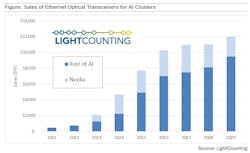Driven by growing demands to support AI clusters, sales of Ethernet optical transceivers continue to jump.
According to LightCounting, this new market segment will more than double in 2024.
The research firm said that while “strong growth is likely to continue in 2025-2026,” it “will not last indefinitely.”
Challenges ahead?
LightCounting’s Forecast projects a “soft landing” in 2027, adding that the market will eventually decline. While the timing of these declines is not easy to predict, the research firm said they usually occur on average every three years.
One issue that could arise is the demand for Ethernet optical transceivers, which will cause supply chain bottlenecks. Customers stockpiling products will further exacerbate this problem.
Like what happened at the end of 2022 and 2019, as the shortages subside, demand could drop, creating excess inventory across the supply chain.
Another critical factor in the optical transceiver market segment is Nvidia.
Several of Nvidia’s customers, including Microsoft, purchase complete systems, including all the transceivers. “This may not be the most economical approach, but it is an arms race,” LightCounting said. “We expect more companies to start bypassing Nvidia for purchases of optical transceivers in the future, reducing Nvidia’s contribution to the market.”
Cloud company race
While Google and Nvidia initially led purchases of optical transceivers, LightCounting said that all major cloud providers are ramping up their inventory.
In particular, the demand for 4x100G and 8x100G transceivers exceeds supply by more than 100%. Several customers will not receive their products until next year.
As a result, LightCounting raised its forecast for 4x100G transceivers by $0.5 billion in 2025 and $1 billion in 2026. Sales of these products are forecast to surpass $4 billion in 2026.
LightCounting said its “forecast for 8x100G transceivers was increased by $2 billion in 2025, and sales of these modules are expected to exceed $7 billion in 2026.”
Another critical factor will be 4x200G and 8x200G transceivers. The research firm expects the first 4x200G and 8x200G transceivers to be shipped in late 2024 and has “sharply increased” its 2025 forecast for these modules.
Additionally, LightCounting has added 3.2 Tbps transceivers to its model. It expects the combined sales of 1.6T and 3.2 transceivers, LPO and CPO, will reach almost $10 billion in 2029, accounting for the bulk of sales of Optics for AI Clusters.
For related articles, visit the Optical Tech Topic Center.
For more information on high-speed transmission systems and suppliers, visit the Lightwave Buyer’s Guide.
To stay abreast of fiber network deployments, subscribe to Lightwave’s Service Providers and Datacom/Data Center newsletters.

Sean Buckley
Sean is responsible for establishing and executing the editorial strategies of Lightwave and Broadband Technology Report across their websites, email newsletters, events, and other information products.

